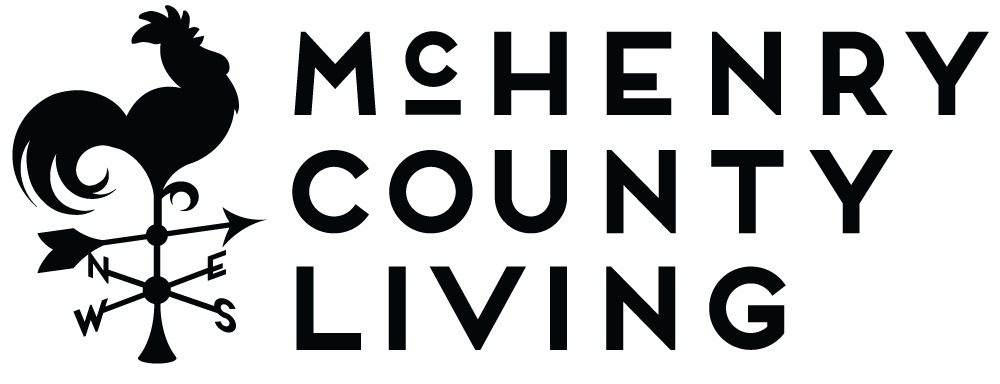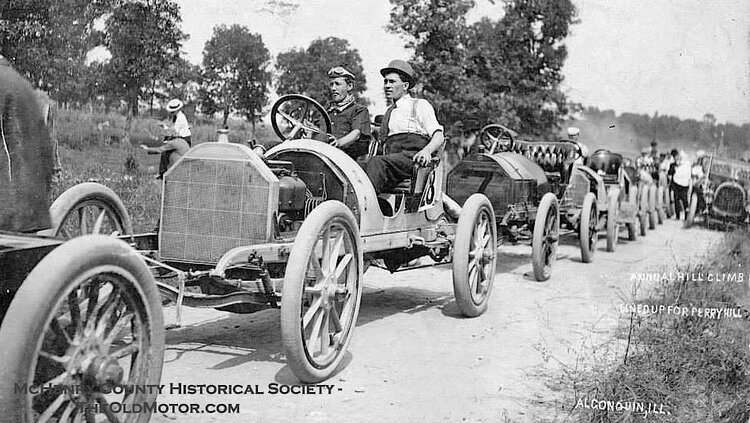Kings of the Hill in Algonquin
A LOOK BACK AT ALGONQUIN HILL CLIMBS CA. 1906-1912.
Did you know that McHenry County’s southernmost village was once a national center of attention for auto racing? From 1906 through 1912, the Algonquin Hill Climbs drew 137 drivers, 83 automakers and more than 50,000 spectators to the “Gem of the Fox River Valley.”
The next time your car is traffic-choked at the intersection of Routes 31 and 62, think of the unfortunate Mr. C.D. Paxson and his 1908 Jackson Roadster. Losing control during the morning climb, Paxson turned wide off Perry Hill and right into the official timer’s tent. This same driver went wild again in the afternoon climb, mowing down a trio of spectators on Phillips Hill; his Jackson’s broken axle, frame and wheel brake all testament to an evident lack of driving skills. Nobody was seriously injured, but Mr. Paxson never again competed in the Algonquin Hill Climbs.
HILLS ARE DISCOVERED…
The hill climbs of 1906-1912 helped put Algonquin on the map. Algonquin of 1906 claimed only three automobile owners among its 600 residents. Yet in early September, hundreds of early model cars and thousands of spectators descended upon this sleepy summer resort town for the first of seven annual hill-climbing competitions. By 1909, street signs for 100 miles around directed motorists by the droves to Algonquin. And in 1910, AAA designated the Algonquin Hill Climbs a national event.
It all began as a reliability contest; that is, more of a performance test than a race. By way of demonstration, Chicago-area proponents of the “horseless age” hoped to silence their skeptics. Yes, these “noisy, smelly dust buggies” were indeed the future of transportation. Similar contests had captivated the general public out East—especially those who had $750 for a brand new Oldsmobile, Duryea or Baker Electric—and Chicago car manufacturers, dealers and automotive enthusiasts hoped to accomplish the same for the Midwest. They decided, therefore, to sway public opinion by sponsoring a first-rate hill climb. There was just one problem: Chicago had no hills. Venturing west, Chris Sinsabaugh, sports editor for the influential “Chicago Daily News,” and Joe Gunther of the Chicago Automobile Trade Association discovered the “real hills” of Algonquin. Here they found the perfect “proving grounds” to “test the mettle” of new automobiles.
A CLASSIC IS BORN…
The Algonquin Hill Climbs quickly became a premier American auto challenge. Always innovative, it was the first to use an automatic timing device, to feature two hills rather than one, and to employ the “flying start,” where motorists gained speed for a quarter mile before crossing the starting line.
Three prominent hills were featured. Phillips Hill, heading north from present-day Main Street and Algonquin Road, served notably from 1906 through 1912. Perry Hill, just south of the county line, was used until 1909 when Kane County grew tired of the ruckus created by an annual flood of visitors and rescinded all hill climbing privileges. Algonquin Hill, at present-day Huntington Drive, replaced Perry Hill and from 1910 through 1912 earned a reputation as the “hardest hill ever attempted.” Race officials embraced the new challenge, a twisting ½-mile climb up a 26-degree incline.
Each hill has since been graded for safety. A century ago, much steeper than today, what a thrill it must have been watching the drivers speed to the top, tires kicking back oil-packed mud and dirt, pushing their machines to the limit while avoiding the throngs of well-dressed onlookers literally crowding the roadsides.
Entries ranged from steam-powered motor buggies, which retailed for under $500, to six-cylinder touring cars that ran upwards of $3,000. Future Indy 500 stars like Len Zengle, Eddie Hearne and Frank Kulick all came to claim the coveted Algonquin Cup. Most extravagant of all was Phil Kirk in his pink Apperson Jack Rabbit, winner of the 1907 Free-for-All. Its 65 horsepower engine topped out at a “guaranteed” 75 mph. No ordinary machine, the Jack Rabbit’s $7,500 price tag was indeed for the rich only. Algonquin’s historic Village Hall, to put things in perspective, was constructed that same year for a mere $6,848.
Motorists raced against the clock in one-minute intervals. Grouped by class, determined by list price and engine type, the fastest car was not always the winning car. An innovative handicapping formula (cylinder capacity x run time ÷ weight of the car) decided who triumphed. Amusingly, scales from the nearby Borden Milk Factory were used for the weigh-in.
The Algonquin Hill Climbs reached its peak popularity in 1909 with 83 drivers representing 29 auto manufacturers before a crowd of 25,000. More than 1,000 automobiles packed the village’s streets. Residents rented out their barns to shelter prized cars. The Governor of Illinois sent Company E of the 3rd Illinois Infantry from Elgin for crowd control. Hotels from Crystal Lake to Carpentersville were at full capacity. And so congested was Algonquin itself that one could only turn around, it was said, by driving straight through town.
BRAGGING RIGHTS WON…
Automakers were quick to boast after a successful showing at the Algonquin Hill Climbs. Ads hit the national media within days. Pierce Arrow, a Buffalo, New York, manufacturer of luxury cars, touted its “Three Time Winner” in the 1907, 1908 and 1909 contests. “Good fortune may win once,” they declared, “but not three years in succession.” Indianapolis-based National took some linguistic liberty in proclaiming its “fore-door” touring car, The Speedway Roadster, a “Marvel of Motordom.” And Chicago’s Holsman, which would cease production of its “High Wheeler” motor buggies in 1910, claimed a 1908 victory proved its 4-cylander supremacy “against the entire field.”
Even those who claimed no trophy found bragging rights. A Maxwell advertisement in the “Chicago Tribune,” for example, noted that its No. 13 car, which went home empty handed thanks to the handicap, outpaced the trophy-winning Buick by a combined 15 seconds for both hills. Woods Electric informed readers that its Queen Victoria, though not finishing first, had outperformed a dozen more expensive gasoline cars.
Jackson Automobile Company praised its hill-climbing prowess by virtue of outperforming Buick, Mitchell, Rio and Rambler cars up Phillips Hill, despite the brakes being locked “most of the way.” This speaks volumes for the value consumers put on speed and endurance, not so much, perhaps, for an auto’s ability to stop.
…AND AN ERA ABRUPTLY ENDS
The Algonquin Hill Climbs’ success in championing the automobile age had ironically helped make the contest itself obsolete. By 1912, new cars performed so well that the town’s hills no longer seemed so daunting. Fewer than 20 motorists competed that year. Frank Kulick, driving a Ford Bearcat took three of five trophies against the diminished field. His 15.4 seconds up Algonquin Hill annihilated all past speed records. The following year’s Algonquin Hill Climbs were cancelled for lack of interest.
Briefly resurrected as the Antique Auto Hill Climb Festival from 2004 to 2006, the nostalgia was short-lived due to funding restraints. But today, we can still recognize this classic auto challenge whenever driving through Algonquin. The next time you pass the cemetery atop Route 31, the appropriately named Hill Climb Park along Huntingon Drive, old Phillips and Algonquin Hills, remember those kings of the hill from one century ago and their historic deeds at the Algonquin Hill Climbs.

